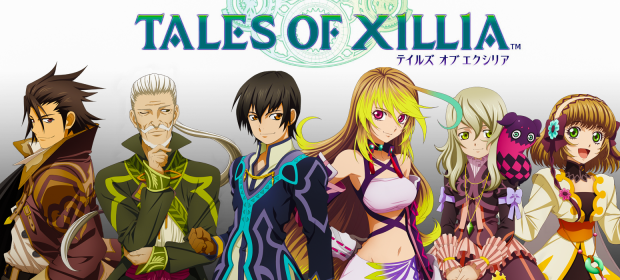Namco debuted their Tales series on the Super Famicom back in 1995. Beginning as a turn based, very traditional JRPG affair, the series evolved nicely to the point that more latter-day instalments like Tales of Symphonia and Vesperia were highly enjoyable adventures that specialised in an innovative brand of fast-paced, real time combat. Whilst they aren’t sitting at the top table with your Final Fantasies, Dragon Quests and Personas, you can generally rely on a Tales sequel to provide a solid chunk of fantasy role-playing action.
Japanese audiences and critics adored the latest instalment in the series, Tales of Xillia, when it was released in 2011. Like many of the preceding titles, it spawned myriad tie-ins, including novelizations, anime, Special Edition packages and even a sequel. Quite why this is the case boggles the mind, as it’s a weak entry in the Tales canon with plenty of problems that we cannot be alone in picking up on. The step to localise it for the West is consistent with Namco’s past activity, yet this is one two year-old romp we could have safely gone without.
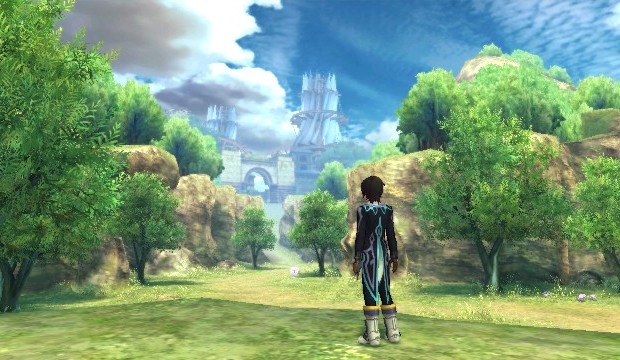
Set in the land of Reize Maxia, you play one of two main selectable characters: the wide eyed, spiky-haired and incredibly dull med student Jude, or Milla, a disappointing cookie-cutter anime lass with a moody attitude, extraordinary mane of hair and predictable air of spirit-based mystery. The pair exist in a time where humans have evolved enough to use part of their brain to employ mana and in turn access magical powers. The game opens in a suitably steam-punky medical school and research facility, where the pair uncovers an evil plot to power a devastating weapon using mana pinched from unsuspecting victims in the vicinity. Moving forward, you get to add more characters to your party, including a little girl with a talking doll. But this is a tale hewn from clichés, packed with dishwater dialogue, boring characters and unimaginative settings.
A good role player grabs your attention straight away, creates a reason to keep you interested, something to drag you into its powerful clutches and never let you go. Xillia eschews this in favour of a tedious trudge around a bland medical school setting, a murky sewer and then a seemingly endless, grey/green research building. The enemies here are lousy, which is standard, you might argue – after all, you have to learn the ropes somewhere. But even early on there are loads of them, and they can be defeated in less than three seconds. There are some treasure chests, which contain items that can be used and combined and tinkered with later on – but they are as uninspiring as the settings. Within the first eight minutes I had collected a lump of wood and some dung. Thanks! Remember how Resident Evil used to have shiny glittery indicators when there was an item? That happens here too.
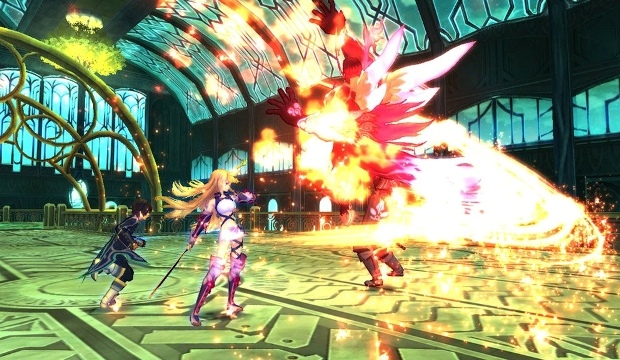
The voice localisation job is a dreadful reading of a lousy script, and can be switched off so you can just listen to the decent music instead. The game doesn’t look great – starting out murky and dull and not improving significantly as you progress. There are jarring differences between the main characters – who are straight out of Anime 101 and designed by the same bloke who did character design for Sakura Wars – and the strange, haunted looking anatomically accurate NPC characters. It also suffers from pop-up that makes Dynasty Warriors come off favourably in comparison, as you wander around towns and villages and figures appear out of thin air.
There isn’t really a great deal to do in this game outside of the rigid main storyline; you travel around, speak to people, upgrade your gear, read through the endless skit conversations, or take on side quests. You pick up quests by speaking to NPCs with an exclamation mark over their heads, and are usually tasked with performing a familiar chore – find a person or item, slay some monsters. This soon becomes frustrating when your objectives are not readily indicated on the world map, which can lead to you wandering around for aeons trying to find your target. Most of the field areas have a ridiculous amount of enemies, as well as respawning items and treasures. The game is perfectly poised if you are into grinding, as you could easily run backwards and forth, slaying giant scorpion beasts and picking up money and items for ages.
What Xillia does have, though, is an absolutely cracking combat system (which is utterly wasted), and a cool Lilium Orb levelling-up matrix. Each time you level up you earn Growth Points, which allow you to enter a sub-screen and link together various orbs that grant abilities and stat boosts. It allows you to use the GP to tailor a character that best suits your playing style, and is most welcome.
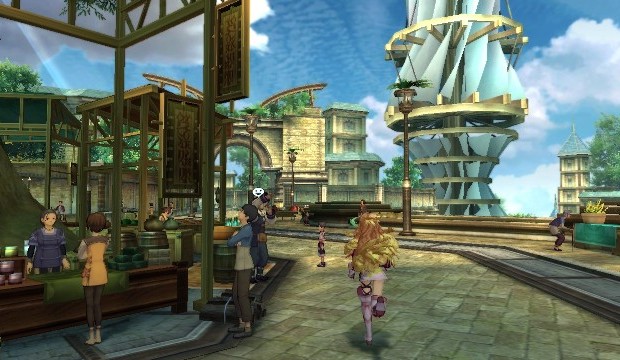
Including, yet going beyond, the notion of elemental attacks and status altering poisons and magics, once the 3D battles start coming thick and fast, you realise that there are a crazy, almost overwhelming, number of combos and mechanics at your disposal. But despite a superb tutorial system which explains in supreme clarity the superlative array of tricks, guards, steps, blows and magical Artes – 99% of the time the game allows you to win simply by pressing the X button, or alternating between X and O, until you meet up with a tougher boss character who needs a bit of strategy. If you do want to pretend that everything is hunky dory, then you can use the brilliant linking system that allows you to fight in tandem with a partner, joined together by a virtual, indicative blue line. Once you link up with a buddy, they will attack the same enemy as you, and make calculated and logical moves – such as getting behind the enemy so you have it surrounded. There are awesome linked super Artes available, and between you and your partner you can juggle and combo the enemies beautifully. Characters have their own special abilities – such as Jude’s handy teleportation trick which allows him to reappear behind an enemy.
Everything whips along at 60fps, as smooth as silk, making it one of the most fluid battle systems I have seen in an rpg. It all works so well, yet still most battles are easily won without doing anything other than slamming two buttons, even if you have run out of Assault Count Points which are supposed to limit the frequency of your attacks. A wonderful way of displaying this comes little more than fifteen minutes in. When you first encounter Milla, she comes equipped with a super-badass set of Artes and abilities, and helps Jude out of a sticky situation by summoning a mighty spirit to save his hide. This cuts what was looking like a tricky battle down to a meagre couple of seconds. Soon after, Milla is stripped of her powers, but when you next fight, it is like absolutely nothing has changed, and you still win in super quick fashion nearly every time. Hell, you don’t even have to do anything in battles if you don’t want to; you can assign commands to everyone in your party and, thanks to the decent AI, that usually does the job just fine.
It is almost too easy to criticise JRPGs, such is the propensity of developers to trot out the same old clichés and retreads, over and over. It is a genre that needs something a bit special for a game to stand out. Gone are the days when Western fans would be happy enough just to get a release of an anticipated Japanese title. Earthbound, which we recently looked at, did just that, whilst poking fun at the turn based combat and aforementioned clichés at the same time.
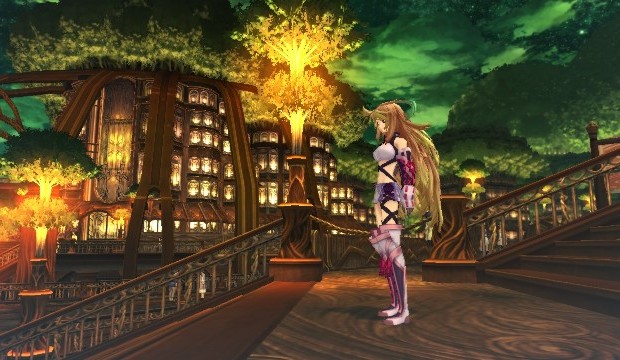
VERDICT: This year we have been blessed with the exceptional Ni No Kuni, which married resolutely old-school adventuring with a plot and aesthetic style that made it perhaps the ultimate homage to the games we grew up adoring. Tales of Xillia doesn’t come close to its aforementioned forebears. It is the quintessential “bog standard” JRPG, a sad showing considering it’s part of a recognised and long-running franchise that has certainly hit some impressive highs in the past. It manages to make a killer combat engine redundant and boring, and comes across as a lazy, poorly-engineered mess in all other areas. With a cliché-laden story and drab characters, the personal and emotional investment remains low. Namco have a fighting engine here that deserves a better game.

DECENT. A 6/10 indicates that, while this game could be much better, it still has a fair amount to offer the player. It might be an interesting title sabotaged by its own ambition, or a game denied greater praise by some questionable design choices. Don’t avoid it outright, but approach it with caution.


